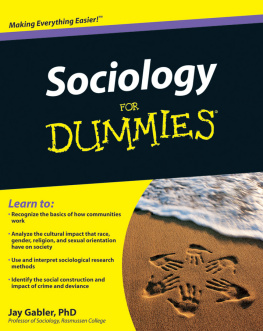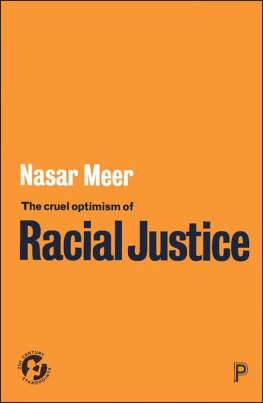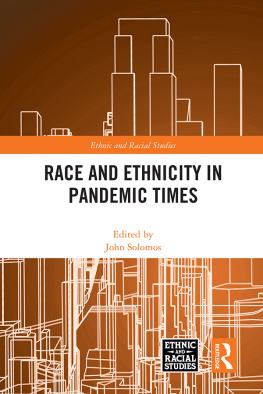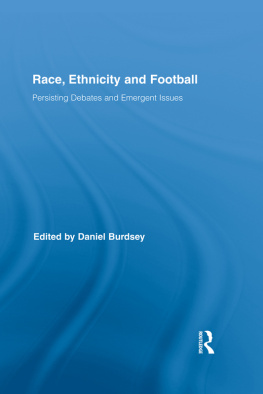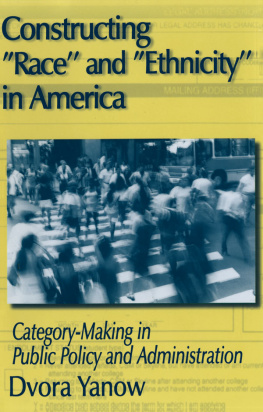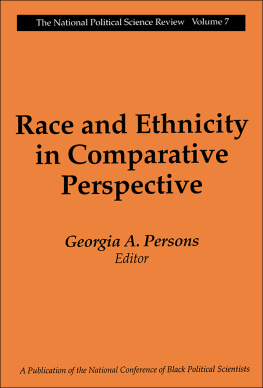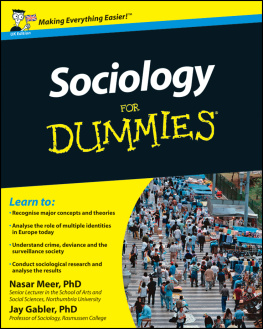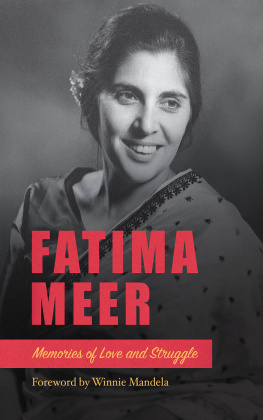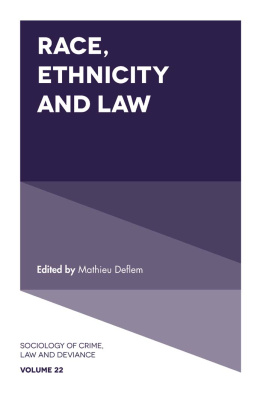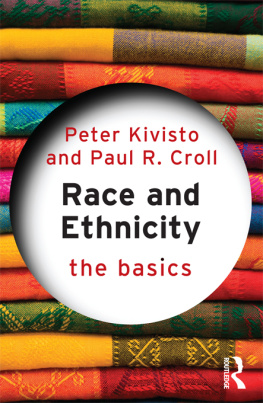Key Concepts in Race and Ethnicity
Recent volumes include:
Key Concepts in Migration
David Bartram, Maritsa Poros and Pierre Monforte
Key Concepts in Sociology
Peter Bramham
Key Concepts in Childhood Studies 2e
Allison James and Adrian James
Key Concepts in Youth Studies
Mark Cieslik and Donald Simpson
Key Concepts in Family Studies
Jane Ribbens McCarthy and Rosalind Edwards
Key Concepts in Drugs and Society
Ross Coomber, Karen McElrath, Fiona Measham and Karenza Moore
Key Concepts in Classical Social Theory
Alex Law
Key Concepts in Social Work Practice
Aidan Worsley, Tim Mann, Angela Olsen and Elizabeth Mason
Key Concepts in Race and Ethnicity
Third Edition
SAGE Publications Ltd
1 Olivers Yard
55 City Road
London EC1Y 1SP
SAGE Publications Inc.
2455 Teller Road
Thousand Oaks, California 91320
SAGE Publications India Pvt Ltd
B 1/I 1 Mohan Cooperative Industrial Area
Mathura Road
New Delhi 110 044
SAGE Publications Asia-Pacific Pte Ltd
3 Church Street
#10-04 Samsung Hub
Singapore 049483
Nasar Meer 2014
First published 2014
Apart from any fair dealing for the purposes of research or private study, or criticism or review, as permitted under the Copyright, Designs and Patents Act, 1988, this publication may be reproduced, stored or transmitted in any form, or by any means, only with the prior permission in writing of the publishers, or in the case of reprographic reproduction, in accordance with the terms of licences issued by the Copyright Licensing Agency. Enquiries concerning reproduction outside those terms should be sent to the publishers.
Library of Congress Control Number: 2013955942
British Library Cataloguing in Publication data
A catalogue record for this book is available from the British Library
ISBN 978-0-85702-867-9
ISBN 978-0-85702-868-6 (pbk)
Editor: Chris Rojek
Editorial assistant: Gemma Shields
Production editor: Katherine Haw
Copyeditor: Neil Dowden
Marketing manager: Michael Ainsley
Cover design: Wendy Scott
Typeset by: C&M Digitals (P) Ltd, Chennai, India
Printed in India at Replika Press Pvt Ltd
To all my family, and most recently Rashida Clarke Meer (b. 2011) who arrived early to meet Khizer Mohammed Meer (19272012)
About the Author
Dr Nasar Meeris Reader in Comparative Social Policy and Citizenship, and Chancellors Fellow in the Faculty of Humanities and Social Sciences at the University of Strathclyde. He has been a Minda de Gunzberg Fellow at Harvard University, a Resident Fellow with the Institute for Advanced Studies in the Humanities (IASH) at the University of Edinburgh, and a member of the British Councils Outreach Programme. He is currently a Routledge Super Author and has previously studied at the Universities of Essex, Edinburgh and Bristol, and held a Visiting Fellowship with the W.E.B. Du Bois Institute for African and African-American Research, Harvard University, and the Department of Political Science and Government at Aarhus University. Nasar was previously a Reader, Co-Director of the Centre for Civil Society and Citizenship (CCSC), and senior lecturer at Northumbria University, a lecturer at the University of Southampton, and a researcher at the Centre for the Study of Ethnicity and Citizenship (CSEC), Bristol University, where he is an Honorary Fellow. www.nasarmeer.com
Acknowledgements
This book reflects an accumulated process of learning; something that arguably places me in a debt to both my teachers and students alike. Inevitably this debt takes a diffuse course and could not be traced to one or other class room, whether I was in the audience or at the podium. Nonetheless, and as I set out in more detail in the discussion of reflexivity, the book relies on continuous thinking made possible through collaboration and dialogue with friends and colleagues. Amongst those who I would especially like to name here include Tariq Modood, John Solomos, Anna Triandafyllidou, Per Mouritsen, Anoop Nayak, Varun Uberoi, Claire Alexander, Ray Taras, Jan Dobbernack, Brian Klug, Therese OToole, Tehseen Noorani, Derek McGhee, Pnina Werbner, Claire Blencowe, Bernard Harris, Carol Stephenson, Les Back and Ruth Lewis. Significant thanks are owed to Chris Rojek who commissioned the book some years ago when I was at Southampton University, and waited patiently with Gemma Shields and Katherine Haw at SAGE. The majority of the book was penned during my time at Northumbria University, and I will always be grateful to colleagues for creating and sustaining an intellectually rewarding space in the Department of Social Sciences and Languages. I am obliged to SAGE Publications for kind permission to reproduce a figure from Pieterse, J. N. (2001) Hybridity, so what? The anti-hybridity backlash and the riddles of recognition, Theory, Culture and Society, 18 (23): 21945. Finally, the book would never have been completed without the support and encouragement of Katherine Smith, and for which I am profoundly fortunate.
Introduction Please Read this First!
Why a New Book on Race and Ethnicity?
The study of race and ethnicity is a dynamic field. For some readers this will be self-evidently the case. Why? Because human populations and the social relations they constitute are constantly developing, and so our conceptual language needs to meet the challenge of valid description. But the task for social scientists is much greater than may at first appear. In order for our analyses to be meaningful they also have to be reflexive. In our case this means that we need to think critically about the intellectual frames through which we have come to understand what we name as racial and ethnic differences amongst and across populations. Meeting this challenge is important. Not doing so invites the risk that we can ignore how through our concepts we sometimes help constitute those social relations we wish to study.
As a teacher and researcher in race and ethnicity studies, it has become clear to me that while the status of some concepts has been so significant that they have helped structure the field (e.g. blackness, ethnicity, integration, race, race relations), and while others are much more novel (e.g. hybridity, intersectionality, mixedness, transnationalism, whiteness), the status of established and novel concepts does not necessarily reflect an incremental development in our learning. To put it another way, more recent concepts do not necessarily describe more recent phenomena. So while there are several introductory books on race and ethnicity, one of the strengths of this collection is that it is able to illustrate how it may equally be the case that our conceptualisation of new phenomena is only now able to register something that may have long been in evidence. This is not to say other things remain the same (on the contrary) but instead that few other introductory collections seek to offer the analytical range of this book not merely in describing but also critiquing with real world examples.








